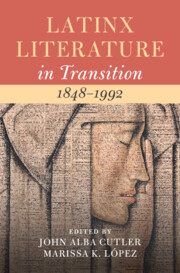Book contents
- Latinx Literature in Transition, 1848–1992
- Latinx literature in transition
- Latinx Literature in Transition, 1848–1992
- Copyright page
- Dedication
- Contents
- Figures
- Contributors
- Acknowledgments
- Introduction
- Part I Space
- Part II Being
- Chapter 5 Brown Modernism from María Cristina Mena to Gloria Anzaldúa
- Chapter 6 The Spanish–Indigenous Binary and Anti-Blackness as Literary Inheritance
- Chapter 7 The Camaraderie of Influence
- Chapter 8 Spiritual Service and Gendered Labor
- Part III Time
- Part IV Form
- Part V Labor
- Bibliography
- Index
- References
Chapter 5 - Brown Modernism from María Cristina Mena to Gloria Anzaldúa
from Part II - Being
Published online by Cambridge University Press: 10 April 2025
- Latinx Literature in Transition, 1848–1992
- Latinx literature in transition
- Latinx Literature in Transition, 1848–1992
- Copyright page
- Dedication
- Contents
- Figures
- Contributors
- Acknowledgments
- Introduction
- Part I Space
- Part II Being
- Chapter 5 Brown Modernism from María Cristina Mena to Gloria Anzaldúa
- Chapter 6 The Spanish–Indigenous Binary and Anti-Blackness as Literary Inheritance
- Chapter 7 The Camaraderie of Influence
- Chapter 8 Spiritual Service and Gendered Labor
- Part III Time
- Part IV Form
- Part V Labor
- Bibliography
- Index
- References
Summary
This chapter reads María Cristina Mena’s “The Birth of the God of War” (1914) alongside Gloria Anzaldúa’s concept of the Coyolxauhqui imperative in Light in the Dark/Luz in lo Oscuro: Rewriting Identity, Spirituality, Reality (2015) to theorize brown modernism. Building on the work of José Esteban Muñoz, who theorizes a “sense of brown” that emerges from a felt community based on brownness,” I contend that Mena’s and Anzaldúa’s engagement with Aztec myths allows them to theorize brownness by centering indigeneity through a feminist lens. In this way, both authors illuminate the divergent modernities that attend their depictions and engagement with indigeneity. Focusing on brown modernism over white modernism illuminates how different modernisms have their own temporalities as brown modernism drags modernist aesthetics deeper into the twentieth century. Moreover, this chapter shows how, in taking up an explicit engagement with indigeneity, brown modernism stresses the importance of having such conversations, particularly when such engagements are uncomfortable and problematic. Doing so allows for a deeper accounting of the kinship between Chicanxs – and Latinxs more broadly – and indigeneity.
Keywords
- Type
- Chapter
- Information
- Latinx Literature in Transition, 1848–1992 , pp. 95 - 110Publisher: Cambridge University PressPrint publication year: 2025

